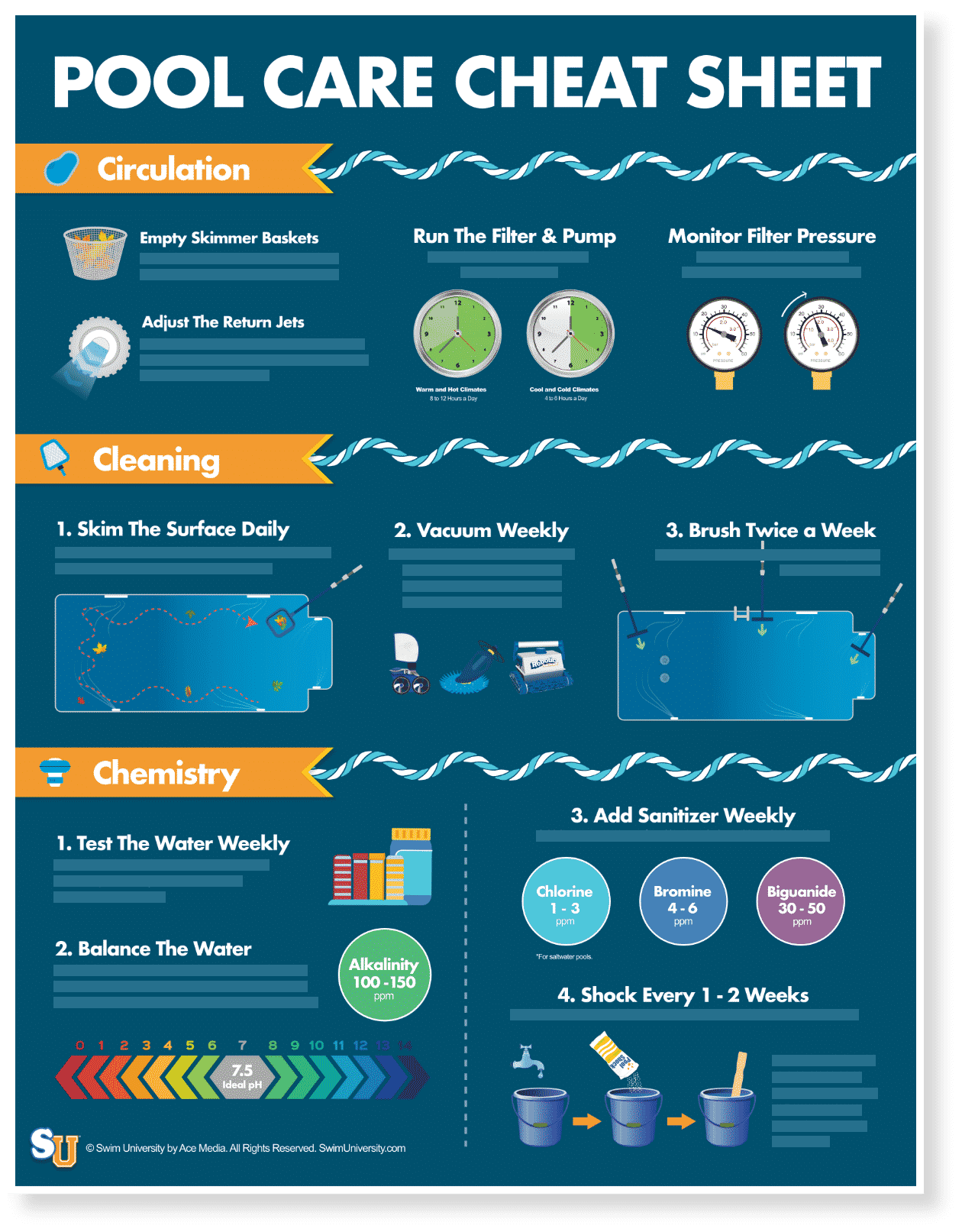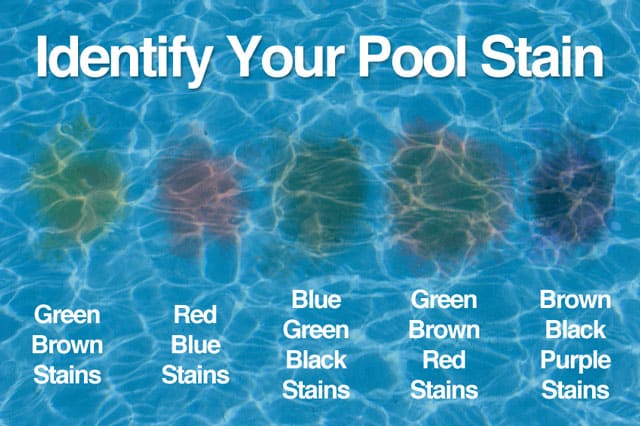Why Clear Plastic Left a Blue Stain on Fiberglass
Download Our FREE Pool Care Cheat Sheet
This free printable cheat sheet helps keep your inground, above ground, or Intex pool clean and clear without messing with confusing water chemistry.
Get The FREE Cheat Sheet

How to Identify and Remove Pool Stains
By Matt Giovanisci | Updated: May 11, 2020
A dirty pool is bad enough. But a stained pool? Yuck! How is that even possible? You're good about cleaning your pool, balancing the water, and keeping the sanitizer level steady. You shouldn't be seeing any stains on your pool walls or floor.
If only that were the case. The truth is, you can be super vigilant about maintenance, and your pool can still end up with stains. The good news is, all you need is a good pool stain remover. The better news is, you can take steps to prevent future pool stains. The key is knowing what caused the stains in the first place.
What Causes Pool Stains?
Before you can choose and apply the correct pool stain remover, you need to determine what stained your pool. The most common pool stains generally fall into two categories:
- Organic: Leaves, berries, and other organic debris can leave stains if they're allowed to settle and left too long on your pool's surfaces.
- Metal: Several types of metal can accidentally be introduced into your pool. Maybe your primary water source is a well, or you have corroded copper pipes in your water system. Rusted metal accessories, parts, and equipment can also cause stains.
Once you determine what type of stain you have, you can decide which type of pool stain remover to use. The best way to figure that out is by the stain's color.

Greenish-Brown Stains
These are most likely organic stains caused by leaves or other plant matter.
Reddish-Blue Stains
These are more than likely from brightly colored berries. If you have berry-bearing trees or bushes near the pool, they're the most likely culprits.
Blueish-Greenish-Black Stains
These could be caused by organic matter like leaves or berries. But if there's nothing like that around your pool, they were likely caused by copper, which can be present in well water. Or if you have copper piping anywhere in your plumbing system, they may be corroded, which can also cause stains.
Greenish-Brownish-Red Stains
This combination is an indication of iron in the water. If you fill your pool with well water, it's highly likely that it contains iron. Or perhaps you have iron somewhere in your pool area, such as a fence. If it rusts, and the rust makes its way into your pool somehow (when it rains, for example), you can end up with stains of these colors.
Brownish-Blackish-Purple Stains
This dark color combination is caused by manganese. This naturally occurring metal is present in well water, but can also be found in municipal water supplies. The water is treated to reduce the amount of manganese, but it's not completely removed.
Determine the Stain's Cause
Once you've got a good idea of what caused the staining in your pool, you'll need to test your theory and confirm the source of the problem.
Organic Stain Test
If you suspect an organic stain, try applying a small amount of chlorine directly to it. If it's truly organic, it should go away easily.
Metal Stain Test
Chlorine has little to no effect on metals. This is why some pool accessories such as ladders are made of metal.
If you suspect a metal stain, apply some ascorbic acid—vitamin C—powder to the stain. If the stain is removed or at least lightened by the powder, it was caused by metal.
Frustrated by adding chemicals and trying to keep your pool clear all the time?
We cut out all the confusion of pool maintenance in this easy-to-read illustrated ebook and video course. It'll help you save $100 right away on pool care!
Click Here to Learn More

How to Get Rid of Pool Stains
Identifying the stains and their sources if only half the battle. Next is removing them.
How To Get Rid of Organic Pool Stains
As the identification test indicated, chlorine is the solution here. But because the amount you use for regular sanitizing isn't enough to remove stains, you'll need to super chlorinate the water. To do that, you'll use pool shock.
Our Top Pick

Calcium Hypochlorite Pool Shock (Cal-Hypo Shock)
This fast-acting, quick-dissolving swimming pool shock from DryTec kills bacteria, controls algae, and destroys organic contaminants in pools. It comes in easy-to-use 1-pound bags.
Use the entire contents of the bag when opened. If any granules settle to the bottom of the pool use brush to disperse them. Add the right dosage of this product during evening hours while the filter pump is running.
Buy Now On Amazon Buy on InTheSwim.com
If you click this link and make a purchase, we earn a commission at no additional cost to you.
- Test and balance the water: Use test strips or a liquid test kit to ensure the alkalinity is between 100 parts per million (ppm) and 150 ppm, which 125 ppm being ideal, and the pH is between 7.4 and 7.6, with 7.5 being ideal.
- Shock the pool: If you're dealing with just one small stain, a regular dose of shock should take care of the problem. But if you have multiple or large stains, to get rid of them with just one round of shocking, use a triple dose. This means adding 3 pounds of calcium hypochlorite shock for every 10,000 gallons of water.
- Brush the pool: Use a stiff pool brush to thoroughly scrub the stains. It's OK if you don't remove them completely at this point.
- Run the pump: Allow the shock to circulate throughout the pool for at least eight hours or overnight.
- Brush the pool again: During those eight hours, or the next day, scrub the stains again.
- Check the stains: Are they gone? Great, you're done! Are they still visible? Repeat the process.
Important: Remember always to shock at dusk, or at night, for best results.
Note: If you're not sure of your pool's volume, you can use a pool calculator to figure it out.
Pool Volume Calculator Click on your pool shape to calculate the volume of water.


How To Get Rid of Metal Pool Stains
Metal stains can be a little more difficult to get rid of, but it's not impossible.
- Test the water for metals: It's a good idea to find out what kind of metal has stained your pool. It can make a difference in the type of pool stain remover you need to get. Some home test kits will test for metals, but your best bet is to take a sample of your pool water to your local pool store and ask them to test it for you.
- Get a metal pool stain remover: Look for one that targets the type of metal that's stained your pool.
- Follow the instructions: Each pool stain remover will work a little differently, so follow the manufacturer's instructions to ensure the best results.

United Chemicals Pool Stain Treat
Pool stain treat is a sequestrate and a chelator that has the strength to remove stains from any kind of swimming pool. Compatible with Baquacil and Soft Swim and works 40-60 days on all pool surfaces.
Buy Now
If you click this link and make a purchase, we earn a commission at no additional cost to you.
06/15/2022 05:33 pm GMT
Preventing Pool Stains
Once you've removed those stains, you'll want to keep them from coming back. It'll keep your pool looking nice, and will save you the extra work of removing them.
How to Prevent Organic Pool Stains
With just a little effort, you can keep organic contaminants from making their mark on your pool—literally.
- Keep the pool water balanced at all times, especially the alkalinity, pH, and sanitizer levels.
- Keep the pool clean by using an robotic pool cleaner, or by manually vacuuming on a regular basis.
- Skim the pool surface often to keep leaves, twigs, and other organic debris from sinking to and settling on the bottom of the pool where they can stain.
- Move plants that bear fruit away from the pool area. If you plan to do some pool landscaping, make sure you plant fruit-bearing trees and shrubs well away from the pool.
- Check the pool regularly for stains. If you find any, take steps to remove them while they're still small.
Our Top Pick

How to Prevent Metal Pool Stains
It'll take a little more vigilance, but you can keep metals from making your pool look ugly.
- Test your water source for metals. If they're present, use a hose filter when filling or refilling your pool.
- Use a metal sequestrant in your pool. This chemical binds with metal particles to keep them from settling on pool surfaces, and to make it possible for them to be removed by the pool filter.
- Maintain your pool plumbing. If any parts of it use copper pipes, check them regularly for corrosion, and replace them when necessary.
- Keep the pH level in your pool steady. This is especially important if you have copper in your water. A low pH level will make the water acidic, which will corrode copper, which will oxidize it, which will stain your pool.
Important: A metal sequestrant is not a metal pool stain remover. It can help prevent stains by making it easier for metals to be removed from the water. But once you have a metal stain, a sequestrant will not remove it.
Finding a stain in your pool can be dismaying at first. But once you're able to identify the cause and the source of the stain, you'll be able to easily remedy it. Then it's just a matter of preventing future stains.
Still, it's always a good idea to keep plenty of pool shock and metal pool stain remover on hand, just in case.
Happy Swimming!
Matt Giovanisci is the founder of Swim University® and has been in the pool and spa industry since 1995. Since then, his mission is to make pool and hot tub care easy for everyone. And each year, he continues to help more people with water chemistry, cleaning, and troubleshooting.
Download Our FREE Pool Care Cheat Sheet
This free printable cheat sheet helps keep your inground, above ground, or Intex pool clean and clear without messing with confusing water chemistry.
Get The FREE Cheat Sheet

Recommended Guides
Source: https://www.swimuniversity.com/pool-stains/